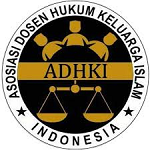Shaking Hands with Linto Baroe and Dara Baroe in a Marriage Party According to Dayah Scholars (Case Study of Suka Makmue District, Nagan Raya Regency)
Berjabat Tangan Dengan Linto Baroe Dan Dara Baroe Dalam Pesta Perkawinan Menurut Ulama Dayah (Studi Kasus Kecamatan Suka Makmue Kabupaten Nagan Raya)
DOI:
https://doi.org/10.22373/hadhanah.v2i2.1734Keywords:
Shaking hands, Linto Baroe, Dara Baroe, Dayah Scholars.Abstract
There are problems related to shaking hands during weddings in Suka Makmue District, Nagan Raya Regency, carried out by people who deviate from the Qur'an, Hadith and cleric opinions, namely people think shaking hands at weddings with linto baroe and dara baroe is something polite and civilized. Even though the scholars agree that shaking hands with non-mahrams is haram. The problems to be investigated in this study are first, how to shake hands between guests and brides linto baroe and dara baroe which was carried out in Suka Makmue sub-district, Nagan Raya district, secondly, how are the views of dayah scholars on the practice of shaking hands between guests with linto baroe and dara baroe at wedding party. This research uses a case study approach, which produces descriptive data in the form of written or spoken words from the people observed. Field research includes interviews and documentation obtained from the community and cleric in Suka Makmue sub-district. From the results of the study, the procession of shaking hands with guests has two processes, namely, firstly, the linto or dara baroe meets the guest to shake hands and the second the guest shakes hands with the bride and groom when the intat linto/dara baroe process is completed by approaching the bride and groom while giving gifts. The results of the study second, the fourth view of the dayah scholars regarding shaking hands with non-mahram guests has several opinions where the legal issue of shaking hands with non-mahram directly is haram, except for small children or the elderly who do not have the potential to cause negative effects (desire and lust). slander). The law of shaking hands between the opposite sex and non-mahram by using gloves or a legal cover (permissible) as long as it does not have the potential to cause lust and slander.
References
Abdillah F Hasan, 101 Rahasia Wanita Muslimah, Jakarta: PT Elex Media Komputindo, 2015.
Abdul Wahab Abdussalam Thawilah, Panduan Berbusana Islami, Jilid 1, Jakarta: Almahira, 2007.
Abdul Wahab Abdussalam Thawilah, Panduan Berbusana Islami, Jilid 1, Jakarta: Almahira, 2007.
Abu Dawud Sulaiman bin al-Asya’ts bin Ishaq bin Basyir, Sunan Abi Dawud, Beirut: al-Maktabah al-ashriyati, t.th.
Bustanul Arifin, “Analisis Hukum Islam Berjabat Tangan Antara Laki-Laki Dan Perempuan Pada Pesta Pernikahan Studi Kasus Desa Bandung Lor, Kunir, Dempet, Demak”, Jepara, Universitas Islam Negeri Nahdlatul Ulama, 2015.
Helfiani, “Hadits-Hadits Kotradiksi Tentang Berjabat TanganDengan Lawan Jenis Yang Bukan Mahram: Studi Kritik Sanad Dan Matan”, (Salatiga, Institut Agama Islam Negeri, 2019).
Ibnu Hajar Ahmad bin Ali, Muhammad Fuad Abdul Baqi (ed), Fathul Baari, Juz 13, Riyadh: Darussalam, t.th.
Iman Malik bin Anas, Muwatha’ Malik Jakarta: Shahih, 2016.
Muhammad Nashiruddin al-Albani, Shahih at Targhib Wa Tarhib lil Mundziri, Jilid 3, Riyadh: Maktabah al- Ma’arif, 1402 H.
Muhammad Nazir, Metode Penelitian, Jakarta: PT Ghalia Indonesia, 2003.
Muhammad Yusuf Riski, “Hukum Berjabat Tangan Antara Laki- Laki Dan Perempuan Bukan Mahram Menurut Yusuf Al-Qaradhawi Dan Muhammad Bin Shalih Al-Utsaimin” Yogyakarta, Universitas Islam Negeri Sunan Kalijaga, 2019.
Nur Aini, Amsal Amri, “Makna Pesan Simbolik Dalam Prosesi Adat Perkawinan Masyarakat Kecamatan Seunagan Kabupaten Nagan Raya”, Vol. 4, No. 1 (2019).
Sarwat Ahmad, Ensiklopedia Fiqih Indonesia 8: Pernikahan, Jakarta: Gramedia Pustaka Utama, 2019.
Soekarto Soerjono, Sosiologi Suatu Pengantar, Jakarta: Rajawaji Pres, 2013.
Downloads
Published
How to Cite
Issue
Section
License
Copyright (c) 2022 Burhanuddin A. Gani, Ida Friatna, Syukri Asnawi

This work is licensed under a Creative Commons Attribution 4.0 International License.

















